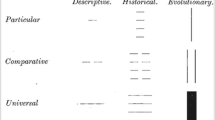
Overview
- Provides detailed SFL-guided descriptions of mood system and mood structure of 60 languages
- Deploys a holistic and systemic approach to the typology of mood
- Reveals cross-linguistic similarities and differences in mood system and mood structure
Part of the book series: The M.A.K. Halliday Library Functional Linguistics Series (TMAKHLFLS)
Access this book
Tax calculation will be finalised at checkout
Other ways to access
About this book
The grammatical category of (sentence) mood has been of central interest to many branches of linguistics, including linguistic typology and systemic functional linguistics. This book is a successful integration of the typological and systemic functional approaches to mood, aiming to investigate the commonalities and variations across languages in both mood system and mood structure. To this aim, it establishes a geographically, genetically and typologically representative sample of 60 languages and provides detailed systemic functional descriptions of the mood system and mood structure of these languages. Based on such descriptions, it makes cross-linguistic comparisons of the mood system and mood structure of the languages in the sample. Structurally, it explores the cross-linguistic commonalities and variations in (i) the realizations of some major functional elements in mood structure, (ii) the realizations of mood options and (iii) the realizations of mood system. Systemically,it investigates how languages resemble and vary from each other in (i) the subtypes of major mood types, (ii) the organization of mood system and (iii) the semantic dimensions along which mood system is elaborated further in delicacy. Moreover, building on the descriptions and comparisons, it makes some generalizations about the structural and systemic features of mood and proposes some tentative explanations for the commonalities and variations languages display in mood system and mood structure. This book is an empirical and holistic approach to the typology of mood and contributes to a deeper understanding of the grammatical category. It is of special interest to systemic functional linguists, typologists, grammarians and descriptive linguists.
Similar content being viewed by others
Table of contents (9 chapters)
-
Front Matter
-
Back Matter
Authors and Affiliations
About the author
Dr. Dongqi Li is a postdoctoral researcher in the School of International Studies at Sun Yat-Sen University, China. He has a M.A. and a Ph.D. in Systemic Functional Linguistics, both from Central China Normal University. His research interests include systemic functional grammar, systemic functional typology and Chinese grammar. He won the National Scholarship for Doctoral Candidates (2018) and the Excellent Ph.D. Thesis Award of CCNU (2020).
Accessibility Information
Accessibility information for this book is coming soon. We're working to make it available as quickly as possible. Thank you for your patience.
Bibliographic Information
Book Title: A Systemic Functional Typology of MOOD
Authors: Dongqi Li
Series Title: The M.A.K. Halliday Library Functional Linguistics Series
DOI: https://doi.org/10.1007/978-981-19-8821-9
Publisher: Springer Singapore
eBook Packages: Religion and Philosophy, Philosophy and Religion (R0)
Copyright Information: The Editor(s) (if applicable) and The Author(s), under exclusive license to Springer Nature Singapore Pte Ltd. 2023
Hardcover ISBN: 978-981-19-8820-2Published: 17 May 2023
Softcover ISBN: 978-981-19-8823-3Published: 18 May 2024
eBook ISBN: 978-981-19-8821-9Published: 16 May 2023
Series ISSN: 2198-9869
Series E-ISSN: 2198-9877
Edition Number: 1
Number of Pages: XXII, 339
Number of Illustrations: 90 b/w illustrations, 3 illustrations in colour
Topics: Linguistics, general, Historical Linguistics, Research Methods in Language and Linguistics



